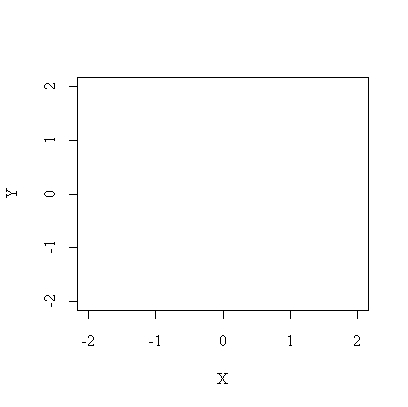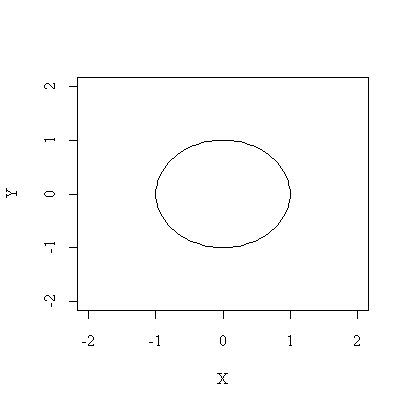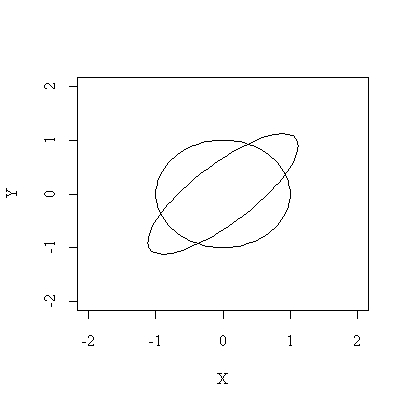 > ellipse()
> ellipse()
 > ellipse(1.5, 0.5, pi/4)
> ellipse(1.5, 0.5, pi/4)

The function ellipse() adds an ellipse to the current plot and has the following arguments:
hlaxa half-length of the major axis (parallel to the X-axis
when theta = 0)
hlaxb half-length of the minor axis
theta angle of rotation, measured counter-clockwise from the
positive X-axis
xc the X-coordinate of the centre
yc the Y-coordinate of the centre
npoints the number of line segments used to approximate the ellipse
As the angle a is incremented evenly in npoints steps from 0 to 2*pi, the (x, y) coordinates are computed for points around the circumference of an ellipse centred at the origin and parallel to the axes. If the angle of rotation theta is non-zero, each (x, y) pair is converted to polar coordinates (rad, alpha) using the function angle(), rotated by angle theta around the origin, then reconverted to rectangular coordinates (x, y). If the ellipse is not centred on the origin, the (x, y) coordinates are shifted by (xc, yc) when they are accumulated in vectors (xp, yp).
> ellipse
function(hlaxa = 1, hlaxb = 1, theta = 0, xc = 0, yc = 0, npoints = 100)
{
xp <- NULL
yp <- NULL
for(i in 0:npoints) {
a <- (2 * pi * i)/npoints
x <- hlaxa * cos(a)
y <- hlaxb * sin(a)
if(theta != 0) {
alpha <- angle(x, y)
rad <- sqrt(x^2 + y^2)
x <- rad * cos(alpha + theta)
y <- rad * sin(alpha + theta)
}
xp <- c(xp, x + xc)
yp <- c(yp, y + yc)
}
lines(xp, yp, type = "l")
invisible()
}
> angle
function(x, y)
{
if(x > 0) {
atan(y/x)
}
else {
if(x < 0 & y != 0) {
atan(y/x) + sign(y) * pi
}
else {
if(x < 0 & y == 0) {
pi
}
else {
if(y != 0) {
(sign(y) * pi)/2
}
else {
NA
}
}
}
}
}
Here we see how ellipse() is used. Note that ellipse() adds the ellipse to an existing plot, so in this example we begin by creating a plot with the required dimensions but no points or lines (type = "n"), then add the default ellipse, a unit circle, which looks elliptical because the plot area is not isometric, and finally add an ellipse with axis half-lengths 1.5 and 0.5 rotated by pi/4 but centred on the origin.
> plot(c(-2,2), c(-2,2), xlab="X", ylab="Y", type="n")> ellipse()
> ellipse(1.5, 0.5, pi/4)